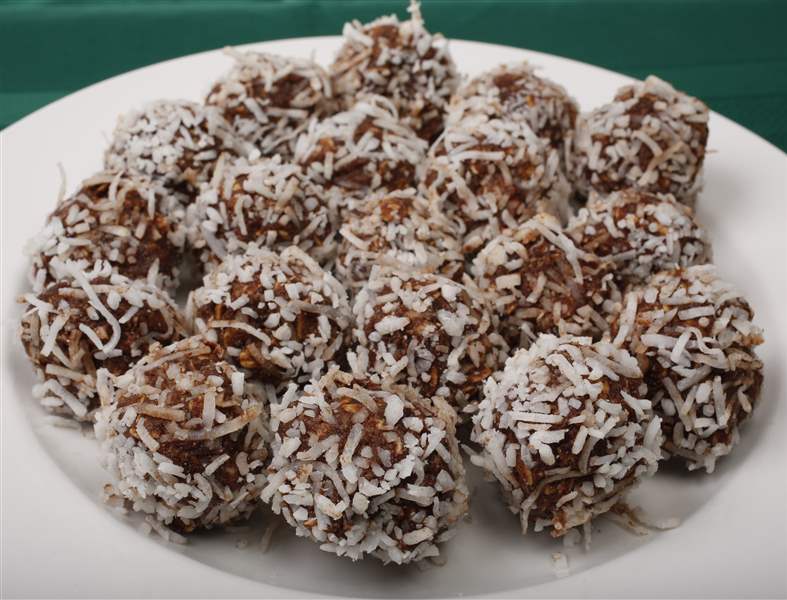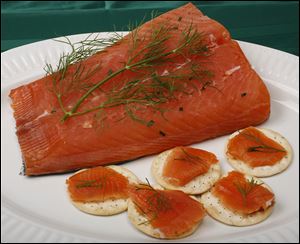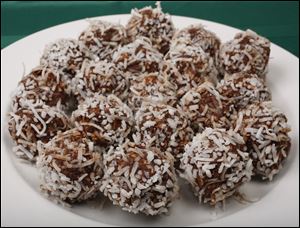
Meatballs & More: Swedish food is diverse, delicious
10/16/2012
Chocolate balls.
The Blade/Jeremy Wadsworth
Buy This Image

Gravlax.
Everyone knows which countries cook up the finest food in the world: France, Italy, and Japan.
And … Sweden?
Don’t scoff. Well, maybe scoff a little. But for the last four years, the Scandinavian country has been promoting itself as The New Culinary Nation. And it is backing up its claims with at least one piece of empirical evidence.
The Bocuse D’Or, named for legendary chef Paul Bocuse, is perhaps the most prestigious cooking competition in the world. The winners tend to come from France and Belgium. But in 1997, the gold medal went to Sweden’s own Mathias Dahlgren, and four times since then Sweden’s chefs have come in second, including Adam Dahlberg this year.
“France and Italy said, ‘What? These Vikings are taking over,’ ” VisitSweden project manager Anne-Marie Hovstadius recently told food writers in Washington.
The rebranding of Sweden as a culinary hot spot is partly an effort to draw more tourists, Ms. Hovstadius admitted. But it is also an attempt to capitalize on circumstances that are uniquely Swedish, or at least uniquely Scandinavian.
Because of the country’s long, dark winters — the most northern part sees literally no sunlight throughout the month of January — the growing season is very short. Foods have to be preserved to tide the residents over until spring, so much of the cuisine is salted or pickled. And because the country is so far north, it makes much use of many foods that are unique to the region, such as reindeer, lingonberries, and cloudberries.

Chocolate balls.
And yet, when Americans think of Swedish food, many tend to think of those little meatballs that were ubiquitous at parties in the 1960s and early ’70s, or perhaps of Swedish Fish, the gummy candy that did, in fact, originate in Sweden. Some may think of lutfisk, the pungent, gelatinous, lye-preserved white fish that is considered repellent by all but a small minority of aficionados. More, perhaps, recollect the ginger snaps — with blue cheese, please — and mulled wine called glögg that are traditionally served at Christmas.
With a recent influx of immigrants, however, Swedish food is changing, said Gabriella Augustsson, spokesman for the Swedish embassy in Washington. “On Fridays, most Swedish families have Taco Fridays.”
But it isn’t tacos that are potentially making Sweden the New Culinary Nation, not even when they are made with reindeer. It’s traditional Swedish cuisine served up with a modern twist.
Few dishes are more traditionally Swedish than gravlax. Served as an appetizer, gravlax combines two of Scandinavia’s most abundant foods, salmon and dill, along with salt to preserve it. And all it takes to make it is time.
There are as many ways to make gravlax as there are Swedes, but the way I do it has always worked for me. I brush a fillet of salmon with lemon and, when I have it, the caraway-flavored liquor called akvavit.
This I cover with a bunch or two of dill and, most important, a healthy layer of salt and sugar mixed together in equal measure. I weigh it down with a couple of cans of food or bottles of beer, and then put it into the refrigerator for 24-48 hours, usually taking it out after about 40 hours. The salt draws liquid out of the fish, keeps it from oxidizing, and makes it safe to eat.
It turns out they actually do eat Swedish meatballs in Sweden, and they are remarkably soft and light (it’s soaking the bread crumbs in milk that does it). According to the Swedish Institute, you can figure out where in the country they were made just by eating them — the farther north you go, the less pork they are likely to have. At Christmas, they are festively spiced with ginger, nutmeg, and cloves, but throughout the rest of the year they are made only with allspice.
At those American parties in the ’60s and ’70s, they were always served with a sauce, often made from chili sauce and grape jelly. In Sweden, it turns out that they do not use any sauce at all; the meatballs are served with lingonberries on the side and potatoes that have been boiled or mashed.
For a rich, fudgy treat try chocolate balls with coconut. No cooking is required, you simply mix cocoa with room-temperature butter, sugar, and rolled oats, and then roll the result in shredded coconut. You’re going to get your hands dirty with this one, but that’s OK — part of the fun comes from licking your fingers clean.
Swedish pancakes are renowned throughout the world for being ethereally light and delicate, yet they are no harder to make than American pancakes. The secret is the batter, which, when you make it, will seem thin. Really thin. Impossibly thin. It will seem like thick milk, but not very thick.
In fact, the batter has almost twice as much milk, by volume, as flour. Poured onto a hot, buttered skillet, it takes only about a minute for each side to get golden brown and delicious. Traditionally it is served with cloudberry jam on the side, but any jam will do — as will powdered sugar or good old American (or Canadian) maple syrup.
The Swedish version of the potato pancake, called raggmunk, is more like a savory version of our breakfast pancake. While Americans often simply fry shredded potatoes and onions, sometimes adding a little flour, the Swedish version uses milk, egg, and a lot more flour. It’s like an American pancake with some potato flavor, and it is addictive. Naturally, the Swedes serve it with jam on the side, lingonberry jam, but you could use any red jam or just enjoy them on their own.
Our dessert of chocolate cookies on raspberries is inspired by a similar dish at the semi-famous P.A.&Co. restaurant in Stokholm, Sweden’s capital. Our version, which was created by the Swedish national culinary team, is a bite-sized chocolate cookie topped with a plump raspberry and melted shreds of white chocolate.
It’s just the perfect dessert to treat yourself to after 24 hours of night.
Contact Daniel Neman at: dneman@theblade.com or 419-724-6155.